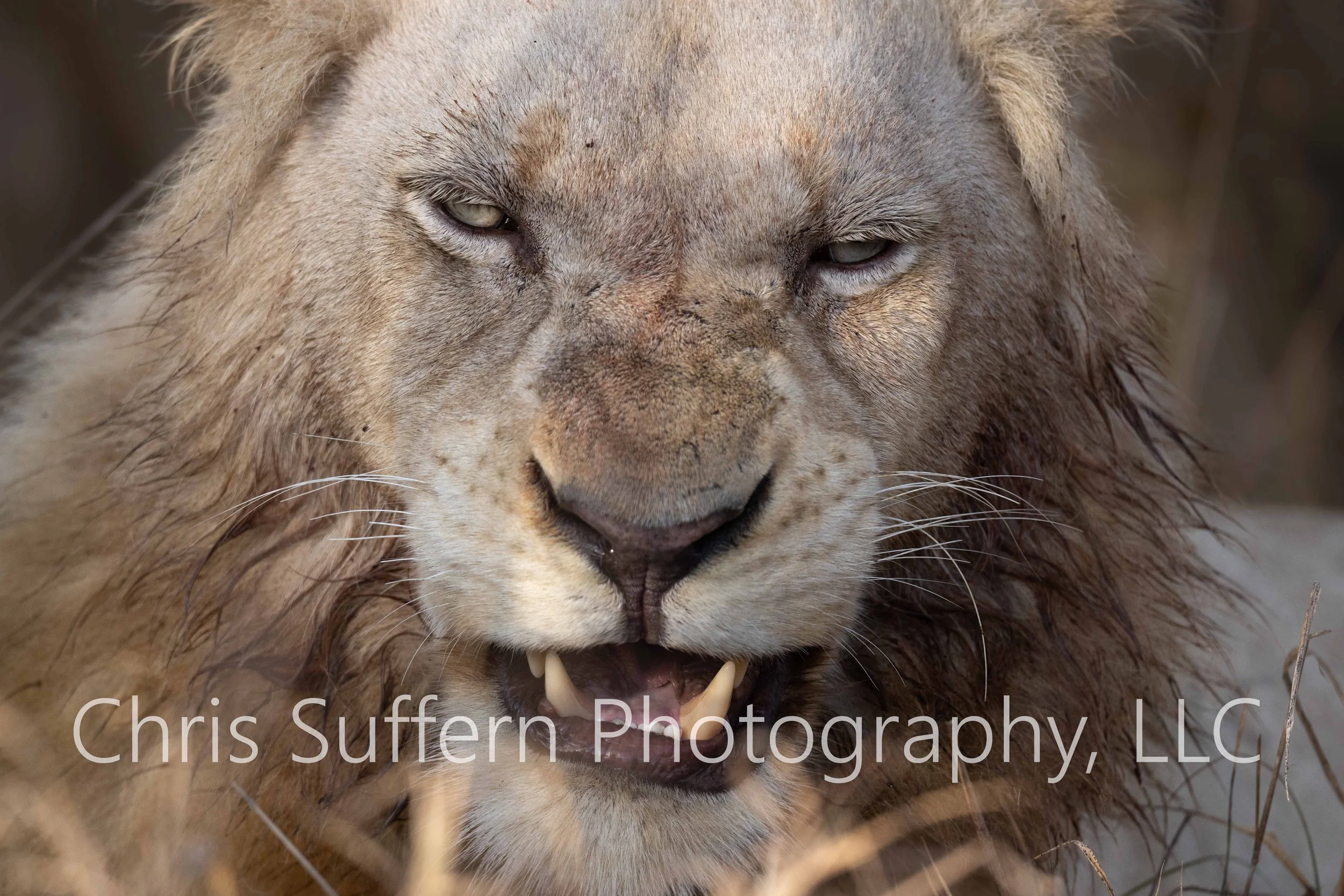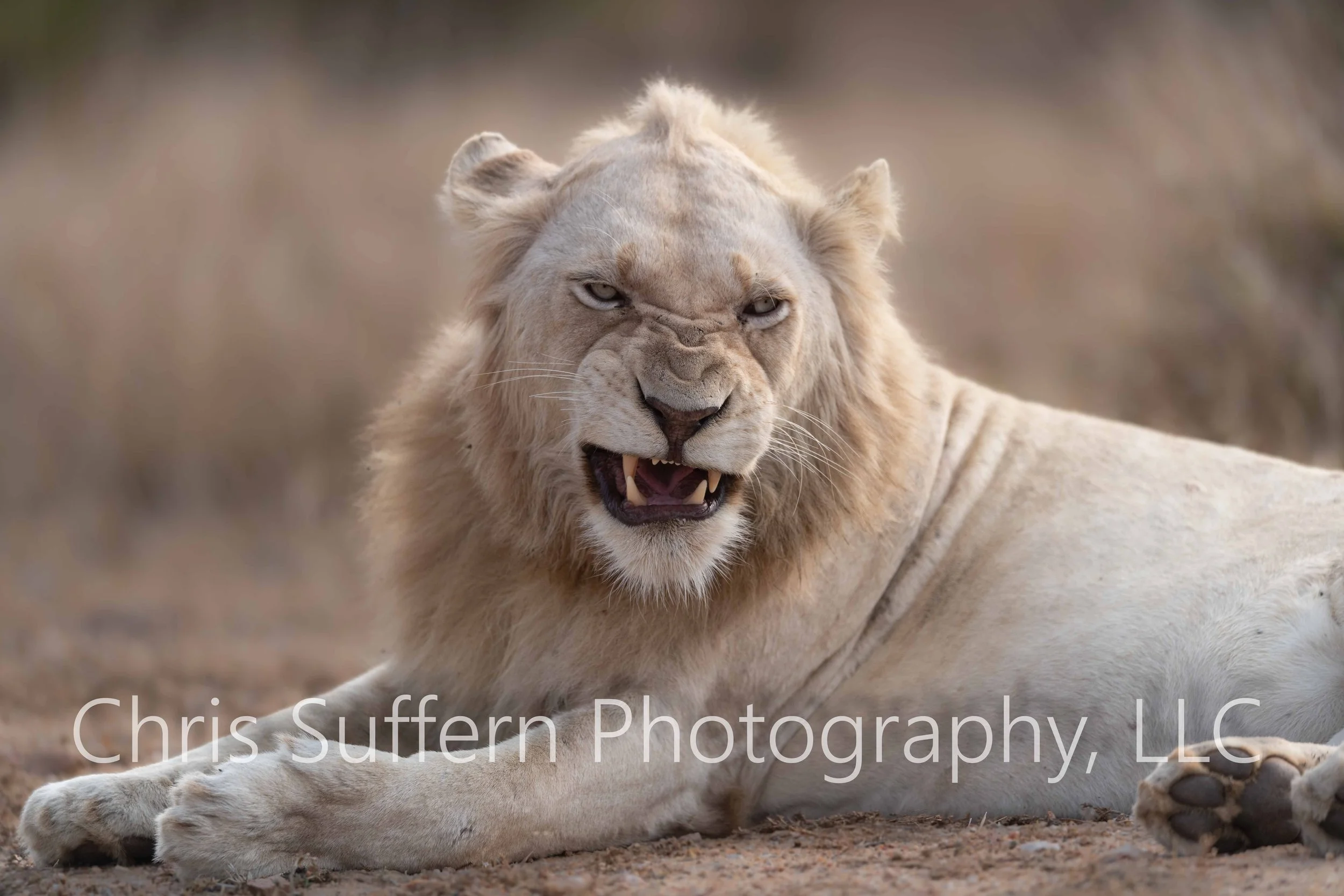White Lions of Timbavati
A vacation house in the city which I consider the most beautiful was the catalyst. Cape Town surrounded by vibrant culture, lush gardens, expansive vineyards, diverse wildlife, and rugged coastline is what I consider an ideal setting for artistic inspiration. The city was the motivating factor which led me back, but it’s hard to travel 15 plus hours solely for a raging metropolis. As diverse as Cape Town is, South Africa hosts some of Africa’s most sought after natural settings. Hiking table mountains presents opportunities to encounter rock hyraxes resting on rocks overlooking the city bowl and wild caracals darting in and out of cervices. Travelling further south to the Cape peninsula offers ostriches, penguins, baboons, and zebras. Eastward towards Hermanus has some of the best land based whale viewing on earth. The list goes on, but my initial stop was farther east, Kruger National Park, the place of my first safari 11 years ago.
Several years earlier I was assigned a former Sabi Sands ranger from South Africa during my visit to Odzala. A bit of an extremist, he hiked the dense forests and marshlands shoeless; it was his shtick I suppose, though the terrain, especially the marsh, was devoid of sharp sticks or bones which would potentially penetrate a bare foot. His luck ran out on one of our hikes as he stepped on bone shard of a poached elephant skull. Maybe a pair of Birkenstocks would have saved his sole. Anyway, we got to talking about all the leopards I saw in the Mara a couple weeks earlier. I maxed out at about 3 in one day. He returned by sharing that he saw a record of 13 in Sabi Sands. Ostentatious. I changed subjects, “well I saw white lions at Sanbona”, I retorted. He replied, “isn’t that place more like a zoo?'“ Then he told me of 2 naturally occurring white cubs of the Birmingham Pride in Kruger. Seemed like an expedition for a wildlife extremist, but I had trips booked well into the future. I had to come up with a good reason to visit the mother city in order to schedule a trip to investigate this genetic specialty.
Like melanistic (black) leopards and jaguars, or leucistic (white) tigers, the coloration of the lions are from homozygous recessive alleles designated by both parents which hold genetic information for white/blonde hair. These animals are not albino as some might think. In nature you can still find black leopards, the most popular one is in Nagarhole, black jaguars in brazil, ask Charles Munn who affectionately refers to them as “BJ’s,” but the tiger’s gene for leucism, which were once found in Bandhavgarh, has been extinct in the wild for many years. The historical stronghold for white lions is the Timbavati region of Kruger national park so of course I had to go.
11 years ago I was in southern Kruger. Lots of rhinos and cape buffalo, but few predators. I saw the tail end of a roaring lion on my last safari. I was a newbie and despite the low density of prime sightings I was hooked. Sights of colorful lilac breasted rollers and 300 plus herds of buffalo were worlds away from the from robins and squirrels of Boston suburbs. The south is good for grazers and browsers, but where I was heading was lion country.
Enter Ngala Lodge, a safari lodge in Eastern Kruger. A good home base for the lions. One special quality was that every day, around lunchtime, several elephants would visit the pool to have a drink. On my last day at least 15 arrived right before I departed. Quite a nice farewell. My guide was a young lady, T, from the southern suburbs; tough, adventurous, and knowledgeable of the bush. Her 4X4 skills were quite impressive. She was accompanied by a spotter who sat on a small chair on the hood of the jeep. He would only ride shotgun when we were close to predators. On the hood he surveyed the road in search of pug marks. His spotting and tracking was impeccable. Upon spotting tracks he could identify the animal and determine how fresh the marks were. We would then track the beast for miles and, if lucky, locate them. The second morning we found the lion’s pug marks. It must have been 3-4hrs as we searched. Some guests had to catch early flights, so our time was limited. My ranger said that we’ll search for another 10mins as we approached the western border of the reserve, an open boundary which we could not pass. Towards the end of the long search, we passed a clearing. I was sure that it would be our last bet, but we saw nothing. We drove another 400m up the road abutting the boundary to the right when the spotter told the ranger to put the car in reverse. We backed up to the same clearing when he said, “there they are!” The same place where we had just passed. Perhaps the their natural camouflage alluded a clear sighting initially, but now we were in the presence of 10 members of the Birmingham Pride, 2 of which were white, 1 male and 1 female. Magnificent! My immediate impression was that they were not as white as those you would see in the Siegfried and Roy freak shows. The hair was more of a creamy light yellow than a brilliant white. Pupils were yellow instead of blue. Despite this, the moment was special as they represented the preservation of genetic diversity which was once believed to be extinct in the wild.
In the afternoon we continued our search. Expectations were high as large predators mostly rest during the warmer hours of the day. The chance that the pride would be within close proximity to their morning location was high and within minutes of entering the Land Rover we received report of such. No rush. Instead we spent time chatting about naturist topics and collected video of grazers.
Several hours later, after other guests had their fill of the pride, we returned to the western border. Light was fading and the pride had moved deeper into the thicket. The bush was no match for the powerful jeep. My ranger bulldozed all within our path as we delve deeper into their territory. Visualization wasn’t great as they progressed into a secluded pocket, but we continued to crush trees, snap branches, and traverse medium sized boulders. A thicker branch was ahead of us. I made no thought of it. The jeep drove over it’s end which flung it with intense velocity directly towards the driver’s seat. With a “ca-chunk,” it smashed into the right temple of my ranger. She was tough and quickly said she was “Ok.” I had a look and witness blood profusely poorly from a deep laceration. I quickly washed away the loose debris, saturated a gauze with peroxide which was applied to her wound. I bandaged her and told her that we should return to the lodge. She apologized for not having a sundowner. I chuckled and reminded her that her safety was more important than a couple shots.
With my initial ranger on the bench, the fill-ins continued to put me in position to capture content. They put me in great locations to get the desired shots of lions feasting, hunting, and going about their daily routine. It’s always delightful to watch the familial dynamics of a pride. Despite their reputation of becoming fierce predators and ferocious killers, the tenderness and comradery shared amongst them is heartwarming. Unlike other big cats, lions hunt, play, and fight together. It’s almost like a gangland brotherhood, hence why they’re such a dominant force. Tigers don’t command the same reverence as they are solitary. Their size advantage is trumped by the pride. A 600lb Bengal tiger is no match for a pride of 20 ravening lions.
I’d consider Timbavati a successful trip. I gathered impressive stills and video of the region. To be honest I almost did not happen as I was confused by the date format used outside of America. Initially I booked a trip for 2023 mistakenly. Right before I submitted funds I quickly realized thaeerror. This was found maybe 1 week after I booked my flights, but Mark at AndBeyond reorganized schedules to make the trip possible. Maybe I did not have as many private jeep safaris as I wanted, but I left content. Kruger has a lot to offer. Timbavati was great, but it’s time to explore other portions of this park the size of Israel.
August 2022




